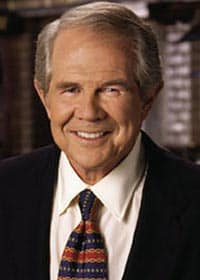Working With the Christian Right
George Halstead, American Renaissance, October 2002

Pat Robertson
The religious right had its glory days in the 1970s and ’80s, and is driven by personalities rather than institutions. Given the questionable things Pat Robertson does, it seems to be sputtering out, and has largely been co-opted by the Republican Party anyway. Also, voters on the religious right can be fickle. Although they may be aligned with the CP or the Republicans, they may decide on a whim not to vote, or that they shouldn’t be engaged in politics at all. As Samuel Francis explains in Revolution from the Middle:
The real problem with the religious right is that, in the long run, its religious vehicle won’t carry it home. If it ever ended abortion, restored school prayer, outlawed sodomy and banned pornography, I suspect, most of its followers would simply declare victory and retire. But having accomplished all of that, the Christian right would have done absolutely nothing to strip the federal government of the power it has seized throughout this century, . . . prevent the inundation of the country by anti-Western immigrants, stop the cultural and racial dispossession of the historic people, or resist the absorption of the American nation into a multicultural and multiracial globalist regime. Indeed, the Christian Right for the most part doesn’t care about these issues or even perceive them as issues, and in so far as it does, it not infrequently lines up on the wrong side of them.
For all its faults, the religious right does offer great opportunities to the movement in terms of coalition building. It has also set an example of dedication to its causes that nationalists would do well to emulate. The religious right is constantly ostracized and publicly ridiculed for its beliefs yet doggedly pursues its goals. Its members have dramatically changed the shape of the Republican Party. They have gotten their own candidates elected to high office, and Republicans now have to take their views into consideration.
In the matter of coalition building, millions of conservative and religious whites could be drawn to the nationalist movement if offered a more compelling political viewpoint. For example, one group, which provides Biblical answers to Christians on the need for immigration reform, is Jim Robb’s organization, Evangelicals for Immigration Reform. Many more members of the religious right could be receptive to a nationalist message if approached in the right way.
While racialist and nationalist Christians need to find a better framework and vocabulary for their views, agnostic and atheistic racialists could find much to learn from the example of the religious right. When encouraged not to lead a hermit-like existence, the religious right has a strong ability to confront tough social issues in a very public and brazen way. Its people are always willing to talk about their issues anywhere and at any time, when others would be embarrassed. In so doing, they are continually finding converts. They have been the “shock troops” of the conservative movement for a long time. There are few other groups on the right that devote as much time as they do to advancing a cause they believe in. Whites need to understand that their racial cause is morally justified, and if the religious right grasps that idea it will be a tenacious advocate.
As a practical matter, people from the religious right show up at campaign headquarters to do the grunt work others disdain. They are good, hard-working, cheerful people, and are greatly appreciated on campaigns (even if some of them love to talk at length about religion while stuffing envelopes). You don’t have to beg them to volunteer. I wish an equal number of, say, immigration reform activists showed up to volunteer, but they do not. Christian activists help candidates get elected through volunteer work and donations, and that in turn gets repaid with staff appointments, and advancement of their political issues. It is through its own efforts that the religious right has gained influence.
Another lesson for racialists to learn from religious activists is that they persisted despite tremendous opposition from the media and even from the Republican Party itself. When the movement became more active in the late ’70s and ’80s, it began a strategy of slowly taking over Republican positions. Its people ran for school board, for county Republican officers, for RNC delegate, and so forth. They encountered heavy resistance from establishment Republicans, but prevailed due to their tenacity.
This approach increased greatly after Pat Robertson ran for President in the Republican primary in 1988. While he did not get the nomination, he ended up using his run as a vehicle to create the Christian Coalition (CC). This group in its heyday consisted of volunteers around the country who would distribute flyers and leaflets “rating” candidates. While the Christian Coalition was a bit crude and unsophisticated at first, it grew into a very savvy operation when Pat Robertson replaced himself with the slick operator Ralph Reed. The CC is now only a shell of what it once was, but it should serve as an example of what a committed group can do in the face of fierce, hostile opposition. It has not achieved all its goals, but it has accomplished far more through politics than it ever would have if its members had just stayed home.
Even though the CC is virtually gone, there are still millions of white Christian Americans who are waiting to hear the good news about white nationalism and why it is morally compatible with their faith. Whites do not have to jettison religion to accommodate racialism. All we lack is a kind of “American Renaissance” of the faith to lead us out of the spiritual quagmire. Religion and race can, and should be, mutually reinforcing. We are stronger together than we can ever be separately.















